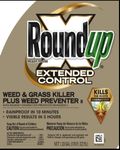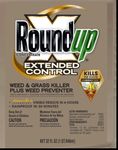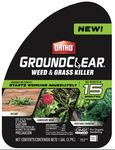Clear Up the Confusion: Know How to Select the Appropriate Herbicide to Control Weeds
←
→
Page content transcription
If your browser does not render page correctly, please read the page content below
az1914 June 2021
Clear Up the Confusion: Know How to Select the
Appropriate Herbicide to Control Weeds
Kai Umeda, Shaku Nair, Michael Chamberland
Figure 1. Colorful and shapely packaged pesticide products on a garden center’s
shelves. Photo by S. Nair
Selecting an appropriate herbicide for a weed problem can ▪ Many can be used selectively and safely in lawns and
be a confusing task. Hoeing weeds would have been a simpler gardens or for total vegetation control in non-crop
task than a baffling experience trying to select an herbicide off areas, patios, driveways, and sidewalks.
the shelf loaded with pesticides. This University of Arizona
▪ Some can be fast-acting, rainfast (resistant to washing
Cooperative Extension bulletin will provide information off from leaves), or long-lasting in the soil to give
describing how to determine which herbicide to use against extended residual control.
weeds in different landscapes.
▪ Herbicides can be ready-to-use (RTU) in a squirt bottle
or purchased as a concentrate of the active ingredient
How to choose the right herbicide when for mixing with water.
many names, descriptions, and claims
are so confusing. (Figure 1) Read the small print on the herbicide
▪ There are numerous herbicide products in the label to know what is in the container
marketplace, many with the same name.
▪ Brand names are catchy to entice the sales of herbicides
▪ Herbicide products are described as being able to ▫ Some familiar names are Roundup*, GroundClear*,
control most weeds (broad-spectrum), grassy weeds,
WeedClear*, Weed B Gon*, Weed Stop*, Preen*,
broadleaved weeds, and to kill the roots, shoots, and
Weed and Feed
leaves.▫ Colorful labels and containers with images of dying This product is called “GroundClear Vegetation Killer – Concentrate”
weeds are appealing, as well as the prices, and
Features:
product claims of the ability to kill most weeds .
▪ 1 year of weed control
▪ The small print lists the active ingredient(s) in the ▪ Quick action within 6 hours
container and its concentration as the important ▪ Can be applied to driveways, sidewalks,
component(s) responsible for ultimately killing the fence lines, patios, gravel areas
weed(s). ▪ Signal word: Warning
▫ Chemical name is the long descriptive chemistry The active ingredients are glyphosate and
e.g. N-(phosphonomethyl)glycine imazapyr.
Glyphosate is a broad-spectrum herbicide
▫ Common name is often a shortened or abbreviated effective in roots and
version of the chemical name, e.g. glyphosate, shoots of most plants.
diquat, imazapic, penoxsulam, sulfentrazone, 2,4-D, Imazapyr is a broad-
spectrum herbicide
dicamba (Figure 2). effective in roots and
shoots of plants and
can last in the soil.
This product is called “GroundClear Weed & Grass Killer”
Features:
▪ Quick action within 15 minutes
▪ Can be applied to patios, landscape
beds, vegetable gardens
▪ Organically certified
▪ Signal word: Caution
The active ingredient is ammonium
nonanoate, also known as the ammonium
salt of pelargonic acid, a long-chain fatty
acid, derived from
beef tallow. It is a
fast-acting burndown
herbicide.
This product is called “GroundClear Weed & Grass Killer Super
Concentrate”
Figure 2. Small print on different herbicide labels showing active ingredients.
Features:
▪ Quick kill formula
▪ Can be applied to patios, landscaped
areas
▪ Kills the roots of weeds
▪ Signal word: Caution
The active ingredients are diquat, fluazifop and
dicamba. Diquat is a fast-acting burndown
herbicide; Fluazifop is effective against
grassy weeds; Dicamba
is effective against
broadleaved weeds.
Figure 2. Small print on different herbicide labels showing active ingredients.
2 The University of Arizona Cooperative Extensioncommercial, and residential/homeowner uses, with varying
Glyphosate in RoundUp* concentrations of active and inert ingredients added to make
RoundUp is a very popular herbicide, that was first up the formulated product (Figure 4). Recently, the name
developed as a sprayable product containing the active “RoundUp” became a marketing brand name targeted for
ingredient glyphosate. It is effective against a broad spectrum retail consumers. “RoundUp” products now include non-
of weeds (non-selectively or indiscriminately killing both glyphosate herbicides that can be used to provide an extended
grasses and broadleaved plants). It acts by entering the plant period of weed control or even be safely used on lawns.
through the leaves and spreads throughout the plant, shoots Glyphosate is chemically an acid that is formulated as a salt to
and roots, to stop new growth and resulting in death. There are enable mixing to be sprayed in water. The concentration of the
many glyphosate-based products available for professional, amount of acid equivalent varies among products (Table 1).
Figure 4. “Roundup” products.
The University of Arizona Cooperative Extension 3Table 1. Different Roundup products with active ingredient compositions, uses, and signal words.
Composition Roundup PowerMax Roundup QuikPro Roundup ProMax Roundup
5.5 lb/gal K† salt 0.73 lb NH4† salt/lb 5.5 lb/gal K† salt ProConcentrate
4.5 lb a.e. product 4.5 lb a.e. 5 lb/gal IPA† salt
66.6% a.e. 3.7 lb a.e.
0.03 lb diquat
Contains surfactant Contains surfactant Contains surfactant
Uses Roundup Ready® crops Professional use Professional use Professional use
Non-crop, industrial sites Non-crop, industrial and Industrial and turf and
turf and ornamental sites ornamental sites
Signal word Caution Caution Caution Caution
K = potassium salt, NH4 = ammonium salt, IPA = Isopropylamine salt
†
Composition Roundup Roundup Super Roundup Roundup Extended Roundup Max
Concentrate Plus Concentrate Concentrate Control Control
glyphosate IPA† glyphosate IPA† glyphosate IPA† glyphosate IPA glyphosate IPA†
1.2 lb a.e./gal + 3.6 lb a.e./gal 18% + triclopyr 1.2 lb. a.e./gal + 1.2 lb a.e./gal +
diquat diquat + imazapic diquat + imazapic
Uses Concentrate plus Super concentrate Brush killer Weed & grass killer Kills vegetation for
+ weed preventer up to 12 months
- Driveways, patios,
sidewalks, gravel
area
Signal word Caution Caution Caution Caution Caution
IPA salt = Isopropylamine salt
†
4 The University of Arizona Cooperative ExtensionComposition Roundup Extended Roundup Extended Roundup Max Control Roundup Max Control
Control Ready to Use Control Concentrate 365 Ready to Use 365 Concentrate
glyphosate IPA glyphosate IPA glyphosate IPA glyphosate IPA
0.06 lb a.e./gal + 1.2 lb. a.e./gal + 0.06 lb a.e./gal + diquat + 1.2 lb a.e./gal + diquat +
pelargonic acid + diquat + imazapic imazapic imazapic
imazapic
Uses Ready to use Concentrate Ready to use Concentrate
- Weed & grass killer + - Weed & grass killer + - Kills vegetation for up to - Kills vegetation for up
weed preventer weed preventer 12 months to 12 months
- Driveways, patios, - Driveways, patios,
sidewalks, gravel area sidewalks, gravel area
Signal word Caution Caution Caution Caution
Composition Roundup Landscape Weed Round for Lawns Roundup for Lawns
Preventer No glyphosate Crabgrass Destroyer
No glyphosate - Penoxsulam, sulfentrazone, No glyphosate
- Pendimethalin 2,4-D dimethylamine salt, - Topramezone
dicamba dimethylamine salt
(Southern lawns)
- MCPA, dimethylamine
salt, quinclorac, dicamba
dimethylamine salt,
sulfentrazone (Northern lawns)
Uses Preemergence 2,4-D and dicamba are Bleaches crabgrass.
- Prevents weeds and grasses effective on the shoots and Topramezone acts on the
up to 6 months. leaves of many broadleaved leaves and shoots of weeds
Pendimethalin acts in the soil weeds. inhibiting the chlorophyll
preventing weed seedling Sulfentrazone is relatively production in plants.
roots to grow. fast-acting for burndown of
nutsedge leaves only.
Penoxsulam acts on some
hard to control weeds.
Signal word Caution Caution Caution
The University of Arizona Cooperative Extension 5Different Roundup’s kill weeds differently Personal Protective Equipment (PPE)
and may cause injury to landscape trees The following PPE or more are recommended during any
and plants pesticide (including herbicide) application: rubber gloves to
There are a multitude of Roundup products that are prevent dermal contact; goggles to prevent eye injury; and
available and they may be formulated with multiple or rubber boots to eliminate contact when walking through
different herbicides so that a broader spectrum of weeds or sprayed areas. Appropriate PPE can greatly reduce the
specific target weeds can be controlled immediately or slowly. potential for pesticide exposure and potential health impacts.
Glyphosate is effective only when it enters the leaves of weeds However, using PPE does not completely eliminate risk.
and eventually kills the plant after a week or so. Different
types of injury may occur on desirable landscape trees and
*Pesticide products mentioned are trademarked brand
shrubs if glyphosate or other combined herbicides drift away
from the intended target weeds. Soil-active herbicides added products not intended to be specifically endorsed for use.
to glyphosate to provide extended preemergence weed control Always read and follow product label instructions before
may injure desirable trees and shrubs if applied near the root using any pesticides. Consult with the University of Arizona
zone or dripline of trees and shrubs. Cooperative Extension or other professional consultants to
ensure safety and reliability of pesticide products for the
Always read the label and understand its intended use.
directions then follow the directions for
proper use of the herbicide. The label is
the law!
▪ Identify and know what weeds are to be targeted
▫ The weed should be listed on the label
▪ Be sure the herbicide can be used where intended
▪ Use recommended label rates, do not cut or double
rates
▪ Apply at the correct time for the appropriate stage of
growth of the weed(s). Herbicides applied at the wrong
time to mature weeds can be ineffective and this wastes
time and money.
▫ Know the precautions and potential hazards of the
selected herbicide
▫ Be safe and know about the signal word AUTHORS
▫ There are herbicides with different modes of action, Kai Umeda
and those that act before (preemergence) or after Area Agent, ANR/Turfgrass
(postemergence) weeds have emerged from the soil. Shaku Nair
Associate in Extension, Community IPM
▪ Wear the proper personal protection equipment (PPE)
Michael Chamberland
▪ Clean up, store, or dispose of container and spray Assistant Agent, ANR/Urban Horticulture
equipment properly CONTACT
Kai Umeda
kumeda@cals.arizona.edu
This information has been reviewed
by University faculty.
extension.arizona.edu/pubs/az1914-2021.pdf
Other titles from Arizona Cooperative Extension
can be found at:
extension.arizona.edu/pubs
Any products, services or organizations that are mentioned, shown or indirectly implied in this publication do not imply endorsement by The University of Arizona.
Issued in furtherance of Cooperative Extension work, acts of May 8 and June 30, 1914, in cooperation with the U.S. Department of Agriculture, Jeffrey C. Silvertooth,
Associate Dean & Director, Extension & Economic Development, College of Agriculture Life Sciences, The University of Arizona.
The University of Arizona is an equal opportunity, affirmative action institution. The University does not discriminate on the basis of race, color, religion, sex, national origin,
age, disability, veteran status, or sexual orientation in its programs and activities.
6 The University of Arizona Cooperative ExtensionYou can also read



























































